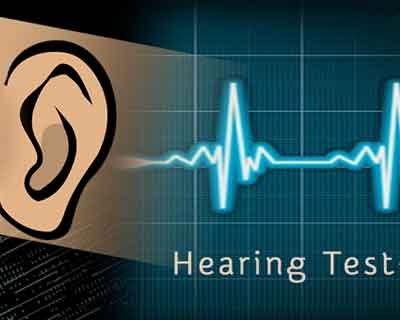- Home
- Editorial
- News
- Practice Guidelines
- Anesthesiology Guidelines
- Cancer Guidelines
- Cardiac Sciences Guidelines
- Critical Care Guidelines
- Dentistry Guidelines
- Dermatology Guidelines
- Diabetes and Endo Guidelines
- Diagnostics Guidelines
- ENT Guidelines
- Featured Practice Guidelines
- Gastroenterology Guidelines
- Geriatrics Guidelines
- Medicine Guidelines
- Nephrology Guidelines
- Neurosciences Guidelines
- Obs and Gynae Guidelines
- Ophthalmology Guidelines
- Orthopaedics Guidelines
- Paediatrics Guidelines
- Psychiatry Guidelines
- Pulmonology Guidelines
- Radiology Guidelines
- Surgery Guidelines
- Urology Guidelines
Hearing test may identify infants with autism risk

New York : A non invasive and inexpensive hearing test may help physicians identify infants with autism risk as researches have discovered that an inner ear deficiency may impact speech recognition ability of children with the disorder.
Autism Spectrum Disorder (ASD) is a neuro-developmental disorder characterised by impairments in social communication skills and restricted and repetitive behaviours.
Some of the earliest and consistent signs of ASD involve auditory communication, however, most tests rely on speech, and are often ineffective in children who are very young or who have communication delays.
The new findings, published in the journal Autism Research, could ultimately be used as a way to identify children at risk for the disorder at an early age.
"This study identifies a simple, safe, and non-invasive method to screen young children for hearing deficits that are associated with Autism," said co-author of the study Anne Luebke, associate professor at University of Rochester Medical Centre in New York.
"This technique may provide clinicians a new window into the disorder and enable us to intervene earlier and help achieve optimal outcomes," Luebke noted.
In the new study, researchers used a technique that measures what are called otoacoustic emissions.
Using miniature speaker/microphone earplugs, the researchers were able to measure hearing deficiencies by listening for signs that the ear is having difficulty processing sounds.
Specifically, the device's highly sensitive microphone can detect minute sound emission made by inner ear outer hair cells in response to certain tones or clicking sounds.
If these cells are not functioning properly, the device fails to detect an emission which indicates that inner ear or cochlear function is impaired.
The researchers tested the hearing of children between the ages of six and 17, roughly half of whom have been diagnosed with ASD.
They found that the children with ASD had hearing difficultly in a specific frequency (1-2 kHz) that is important for processing speech.
They also found a correlation between the degree of cochlear impairment and the severity of ASD symptoms.
"Auditory impairment has long been associated with developmental delay and other problems, such as language deficits," said co-author of the study Loisa Bennetto, associate professor University of Rochester in New York.
"Difficulty in processing speech may contribute to some of the core symptoms of the disease," Bennetto noted.

Disclaimer: This site is primarily intended for healthcare professionals. Any content/information on this website does not replace the advice of medical and/or health professionals and should not be construed as medical/diagnostic advice/endorsement or prescription. Use of this site is subject to our terms of use, privacy policy, advertisement policy. © 2020 Minerva Medical Treatment Pvt Ltd